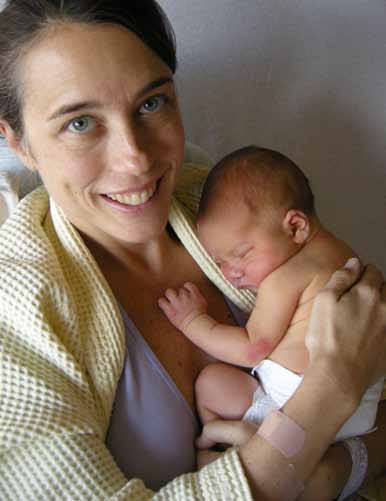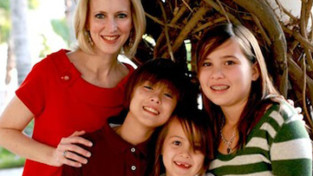Taking Birth Back: Alums Give a Big Push For Midwifery

Jainee McCarroll ’93 with day-old Ellis, who was born with a midwife in attendance. “The support I had was all about getting Ellis here safely and in as simple a way as possible,” she says.
“My mother has very little memory of what it was like to give birth,” says Jainee McCarroll ’93. “She was knocked out and was traumatized by the experience. I wanted to shift the paradigm of my family’s birth history by giving my child the gift of my presence.” So when McCarroll went into labor with son Ellis in 2010, she did it awake and with a midwife’s help. “It was the most intense day of my life,” she recalls, “but the support I had was all about getting Ellis here safely and in as simple a way as possible. It felt like my greatest accomplishment, and I got to do it almost entirely on my own terms.”
For midwives, supporting a woman throughout her pregnancy and birth is equally powerful. Becca Van De Water ’00, a certified nurse-midwife practicing in Juneau, Alaska, says, “A midwife is there to be a best friend, sister, and healthcare provider all at once. My client is beloved to me by the time I’m catching her baby. I have a deep connection to her and all the people in her life. She’s not just a chart. She’s an experience.”
Midwife-attended births are an experience women throughout the world have had for centuries, and are still common in many countries today. In the United States, though, only about one in ten babies is delivered with a midwife’s help.
The numbers aren’t higher here due in part to lingering prejudice against midwifery and a relative lack of qualified midwives. A growing number of alumnae is active in combating the former and providing the latter.
Midwifery is still an often-misunderstood calling, they argue. And the fact that there are many different kinds of midwives, and that training and state licensing rules vary widely, doesn’t help. (Read about the different types of midwives at mana.org/definitions.html.)
The profession encompasses a broad range of services. Besides “catching” babies (a term midwives use in lieu of “delivering”), nurse-midwives, who account for the majority of midwives in the United States, provide services a gynecologist or nurse practitioner might provide, such as family planning, preconception care, pelvic and breast exams, menopausal management, and treatment for infections.
“The main difference between midwives and doctors, says Cynthia Lynch ’90, a certified nurse-midwife practicing in New York, “is that we don’t take care of anyone with a medical problem or whose pregnancy is not progressing within the normal range. We do everything an ob/gyn does, but don’t take care of people with diabetes,those who have heart problems, or those who need a cesarean (“C-section”). We deal with good, old-fashioned, normal pregnancy and birth.”
And midwives take their mission very seriously. Van De Water describes her entry into the profession as a spiritual calling. “It’s the deepest honor and blessing I’ve experienced in my life,” she explains.
“The first time I felt a fetus in the womb was a completely magical and transformative experience,” says Krystel Viehmann ’06, who is studying to become a directentry midwife. “When I placed my hands on that mama’s belly, I felt very strongly changed for the better.”
A Better Birth Experience?
Throughout history, midwives have served as a woman’s primary support during childbirth, but many women today are led to believe that modern medicine trumps the longheld knowledge of midwives.
“We tend to go along with what everyone else is doing, assuming it must be for the best,” writes Ina May Gaskin, founder of The Farm Midwifery Center in Tennessee, in Ina May’s Guide to Childbirth. “Living in a technological society, we tend to think the best of everything is the most expensive kind available. This is generally true, whether we are talking about cell phones, cameras, cars, or computers. When it comes to birth, it ain’t necessarily so.”
Elise Resch ’99, a certified nurse-midwife in a small, privately owned midwifery practice in Connecticut, notes that, “US maternal mortality and morbidity rates are perplexing. We spend more money and use more technology, but have worse outcomes.” For example, the World Bank’s most recent data show that the United States has a maternal mortality rate worse than virtually every European country, and many in Asia and the Middle East.
“American women are starting to ask important questions about why that is. They realize that one in three of them will have major abdominal surgery [i.e. a C-section] to have their babies—more than double the rate the World Health Organization (WHO) recommends. They are beginning to research their childbirth choices, including care providers, very carefully,” says Resch.
According to the American Pregnancy Association, C-sections can increase the risk of infection, hysterectomy, or injury to the bladder or bowel for mothers. Babies born by C-section are more likely to have breathing problems and difficulty breastfeeding. Additionally, more mothers die after C-sections than after vaginal births.
“Most births around the world lead to preventable traumas for mother and baby,” says Jan Tritten, editor of Midwifery Today. “Preventable because many of them are caused by unnecessary and scientifically unjustifiable interventions performed by hospital staff who do not understand how to properly facilitate the normal physiology of birth.”
One way of preventing these traumas, says the WHO, is by using midwives. Research suggests that, for healthy women likely to have low-risk births, midwifery births are safer, less costly, and more satisfying than typical medical-model childbirth. (Read more in the “Evidence-Based Maternity Care Report” at childbirthconnection.org.)
And given that more than 96 percent of births facilitated by certified nurse-midwives occur in hospitals, emergency care—should it become necessary—is nearly always close at hand. Resch, who delivers only at Yale New Haven Hospital, says women come to her because they think the skills and support of a midwife will optimize their chances of a vaginal birth and, hopefully, a meaningful experience.
“I felt it important not to medicalize [the birth process] so much,” recalls Jainee McCarroll. “When I needed medical attention, I was with a midwife who didn’t mess around. She took things seriously, but was also a calm, quiet force for simplicity. We’ve been conditioned to believe birth is a terrifying event, but your body knows what to do. Every cell of your body is summoned, and every cell answers the call.”
Protecting “Normal”
Why don’t more women choose this birth experience? For some, medical conditions make it inappropriate. But even midwifery’s supporters admit there is often a stigma attached to the profession. They trace it back to the early 1800s, when birth attendants in the United States began to shift from midwives to doctors. By the 1920s, home births, previously the norm, were relegated only to women without access to a hospital. This led to a pervasive idea that doctors were better suited to delivering babies, and midwives became marginalized and pushed out of public consciousness.
Slowly, however, a group of passionate women got the word out about the empowerment women could experience through actively choosing their birthing options. Around the 1970s, with the help of advocates such as Ina May Gaskin, midwifery was, you might say, reborn.
Still, America trails far behind other countries in using midwives. According to the National Center for Health Statistics, midwives attended only 7.5 percent of all US births. And a WHO report notes that the Americas average only one midwife for every 20,000 people, the lowest ratio of the six WHO regions worldwide.
One reason may be a perception that midwives lack training that would put them on a level comparable to doctors. Many people may not realize, says Suzanne Wertman ’90, a certified nurse-midwife in North Carolina, that most US midwives have at least a master’s degree from a major university. “I think women who aren’t our clients might think we’re uneducated, ‘crunchy granola’ types, and unsafe,” she explains, adding, “but the women who see midwives for their care are our best and most enthusiastic supporters.” Women such as Jainee McCarroll. “When I tell women about the level of care I received, they’re astonished,” she says. “Two days before I gave birth, my midwife came for a house call. You’d be hard pressed to find an ob/gyn who would do that.”
“We listen, we take the time to get to know our patients, and we trust a woman’s body,” says Wertman. “I wish everyone knew the benefits and how, with a change in focus from disease management to health promotion—using the midwifery model of care—we could have healthier moms and babies in the United States.”
To midwives, a “healthy” birth means a vaginal birth with as little medical and surgical intervention as possible. In some circumstances, medical intervention is crucial, but the midwifery community believes that, in doctor-administered deliveries, medicine and C-sections are often used when not medically necessary, and can largely be avoided.
“The medical model for childbirth is more about labor management than it is about honoring the body’s natural response process,” says Cynthia Lynch. “Doctors have a time frame and want people to be on the curve. If you fall off that curve, they give you drugs and medicalize your birth. They look at pregnancy as a disease process; midwives look at it as a normal function of the body,” Wertman agrees, “Medicine should only be used when needed, but we’ve gotten used to it as being normal. Let the baby come when it’s ready.”
“I have wonderful support from a team of high-risk obgyns who collaborate with us if our patients become highrisk or require a cesarean,” says Resch. “They are excellent specialists and surgeons when our patients need them, but the majority of the time, they don’t.”
Even in unusual circumstances, medical interventions aren’t always wise. For example, one frigid Alaskan winter, a client of Van De Water’s didn’t make it from her hotel to the birthing center in time. When Van De Water arrived at mom and baby’s side, “the baby was nursing, but the paramedics wanted to take them both through the cold air to the hospital for what was probably no good reason,” she recalls. “I stayed three hours to watch them, and they were fine. I think that gets at the heart of midwifery—being creative, solving problems, and protecting ‘normal’ from outside intervention.”

Suzanne Wertman ’90 (left) was midwife to Kerri when she gave birth to Scarlett (right). Wertman currently works for Planned Parenthood, but hopes to return to “catching babies” soon.
When all goes normally, the results are rewarding. Jen McGonagle Dziedzic ’01 gave birth to daughter Emelia at home, with her husband and a midwife by her side. “We had been trying to conceive for a while; then we had nine months of waiting,” she recalls. “To have my daughter at home made everything feel complete. There was so much joy—not throw-a-party kind of joy, but snuggle in bed, hang out with family, stare-at-her-and-be-amazed kind of joy.”
Stigma Remains
In addition to the long, unpredictable hours and the sometimes life-and-death nature of the work, midwives often must fight the medical establishment for recognition, respect, and pay.
“Midwives face a powerful medical lobby when it comes to trying to improve things on a state or national scale,” says Krystel Viehmann. “Out-of-hospital birth centers can now be reimbursed by Medicaid—the first necessary step toward getting midwifery services reimbursed by insurance and included in universal healthcare. We are professionally trained, legitimate healthcare providers. Being seen or treated as anything less has widespread ramifications for women’s choices as well as for the quality of their healthcare.”
“One of the big struggles is getting acknowledgement that we are incredibly trained healthcare providers who happen to practice in some ways that run along a different philosophy than that of the medical world,” echoes Van De Water.
“We struggle with medical insurance reimbursement rates that get smaller and smaller every year,” adds Wertman. “We worry about providing the kind of care women want in a system that rewards interventions and efficiency over relationships and outcomes.”
Malpractice fears, high insurance, low pay, and a perceived inequality within the medical field are realities midwives face, but that hasn’t deterred women (including at least twelve MHC alumnae) from entering the profession.
“Sometimes I get really exhausted from my job, but I keep going back because I know I am called to do this,” says Van De Water. “I’m there for the woman step-by-step through this life process. Midwifery is built on what has been done forever, but we have one foot firmly planted in the medical world. I’m grateful for science, but also for the other foot, which is placed firmly in tradition. I just trust that birth works.”
Resch couldn’t agree more. “The battles continue—to practice, to get covered, to get reimbursed, to break down misconceptions—but as we know, the will of women is strong, and they seem to be taking birth back.”
—By Stefanie Ellis
This article appeared in the fall 2011 issue of the Alumnae Quarterly.
MIDWIVES TAKING BIRTH BACK
For a primer on midwifery, a glossary of midwifery terms, and more, visit alumnae.mtholyoke.edu/midwives.
October 19, 2011










